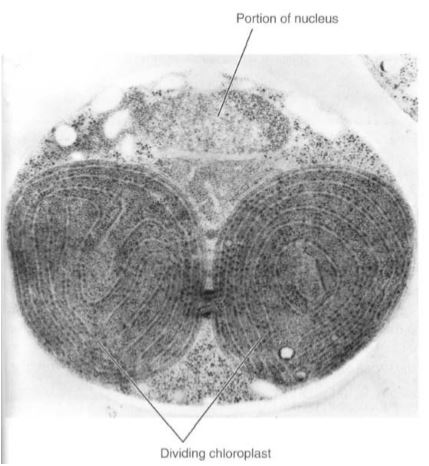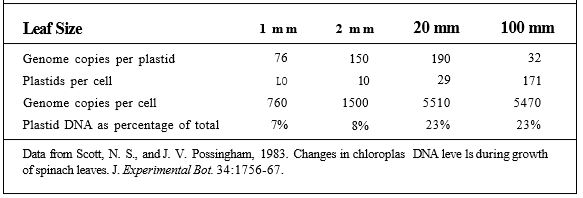
Division of Chloroplasts and Mitochondria
 المؤلف:
AN INTRODUCTION TO PLANT BIOLOGY-1998
المؤلف:
AN INTRODUCTION TO PLANT BIOLOGY-1998
 المصدر:
JAMES D. MAUSETH
المصدر:
JAMES D. MAUSETH
 الجزء والصفحة:
الجزء والصفحة:
 18-10-2016
18-10-2016
 3237
3237
Division of Chloroplasts and Mitochondria
Mitochondria and plastids are constructed similarly to prokaryotes; they also contain circles of naked DNA that become separated by membrane growth. Division of the organelles is accomplished either by infurrowing or by being pulled in two (Fig. 1). Because they contain DNA necessary for their growth and functioning, each daughter cell must receive at least one mitochondrion and one plastid during cytokinesis; if not, the cell lacks that organellar portion of its genome and cannot produce the organelle. This happens occasionally with plastids and is often not a serious problem; the cell survives by importing sugar from neighboring cells and can grow along with the tissue. All daughter cells also lack plastids, so if this occurs in a young leaf, a white spot forms .
The same phenomenon probably occurs with mitochondria but is more difficult to detect. The first daughter cell to lack mitochondria is unable to respire and form adequate amounts of ATP. Because it cannot import ATP from adjacent cells, the cell grows slowly or even dies.
The metabolic stimulus that triggers the replication of nuclear DNA is not the stimulus that controls replication of organellar DNA. During the cell cycle, replication of nuclear DNA is episodic, occurring as discrete episodes that occupy a small portion of the total cell cycle, S phase. But the "duplication" of the rest of the cell seems to be continuous: The volumes of plastids, mitochondria, cytosol, endoplasmic reticulum, and other organelles appear to increase gradually and steadily throughout interphase rather than in discrete episodes.

FIGURE 2 : Micrograph of an algal cell; algae are especially convenient for studying chloroplast division. Because most have only one chloroplast per cell, chloroplast division must be coordinated with cell division. As the chloroplast divides, its central region is pinched inward by a contracting ring of proteins, which constricts the chloroplast into a dumbbell shape .
Chloroplast Division During Leaf Growth
Elegant studies have been done of the growth and division of plastids in relation to the growth and development of leaves in spinach. In very small leaves, 1 mm long or less, plastid DNA constitutes 7% of the total cell DNA, and an average of 76 DNA circles are present in each plastid (Table 1). As the leal doubles in size to 2 mm long, plastid DNA is replicated at about the same rate as nuclear DNA, so it remains low, about 8% of total cellular DNA. As the leaf continues to expand to 20 mm long, plastid DNA is replicated much more rapidly than nuclear DNA and increases to 23% of total cellular DNA. At the same time the number of plastids per cell triples from 10 to 29, so neither plastid division nor plastid DNA replication is controlled by the mechanisms that govern cell or nuclear DNA replication. At this point, each plastid has 190 DNA circles, and each cell has a total of 5510. In the next stage of leaf growth, to 100 mm long, no synthesis of DNA occurs and no new cells form. Instead, those already present expand. However, plastids continue to divide even though they are not making any more DNA; consequently, the number of DNA circles per plastid drops from 190 to 32 while the number of plastids per cell increases from 29 to 171. From these data, it is reasonable to form the hypothesis that plastid growth, DNA replication, division, and development are correlated predominantly with tissue or organ development rather than with the cell cycle.
TABLE 1 Development of the Plastid Genome in Spinach Leaves

least one mitochondrion and one plastid during cytokinesis; if not, the cell lacks that organellar portion of its genome and cannot produce the organelle. This happens occasionally with plastids and is often not a serious problem; the cell survives by importing sugar from neighboring cells and can grow along with the tissue. All daughter cells also lack plastids, so if this occurs in a young leaf, a white spot forms . The same phenomenon probably occurs with mitochondria but is more difficult to detect. The first daughter cell to lack mitochondria is unable to respire and form adequate amounts of ATP. Because it cannot import ATP from adjacent cells, the cell grows slowly or even dies. The metabolic stimulus that triggers the replication of nuclear DNA is not the stimulus that controls replication of organellar DNA. During the cell cycle, replication of nuclear DNA is episodic, occurring as discrete episodes that occupy a small portion of the total cell cycle, S phase. But the "duplication" of the rest of the cell seems to be continuous: The volumes of plastids, mitochondria, cytosol, endoplasmic reticulum, and other organelles appear to increase gradually and steadily throughout interphase rather than in discrete episodes.
 الاكثر قراءة في مواضيع عامة في علم النبات
الاكثر قراءة في مواضيع عامة في علم النبات
 اخر الاخبار
اخر الاخبار
اخبار العتبة العباسية المقدسة


